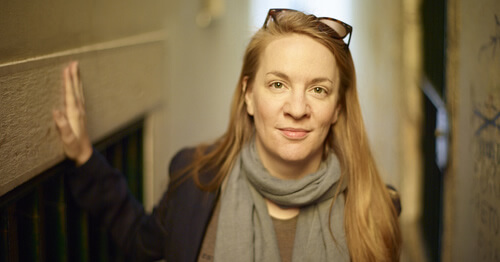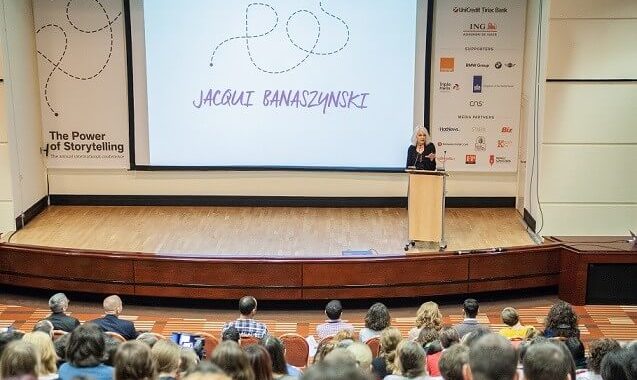2014 speaker Amy O’Leary, formerly of the New York Times and This American Life, has recently announced she is joining Upworthy as the new Editorial Director starting February.
Here’s a recap of some of the advice she shared with The Power of Storytelling audience this fall about what journalists can do so that their stories reach and impact more people.
Get into the feeds first
“Getting into the feeds can mean anything, from making sure the right Google search turns on your headline, to caring about whether your news organization has an app that has alerts, so their phone buzzes when an important story happens. It could mean something that’s simple, that any of you could do, which is having an e-mail newsletter. But it can also mean being on social media, and that’s probably the most obvious example of getting into the feeds first.”
She gave the example of a New York Times article titled Sierra Leone’s Soccer Team Struggles With Stigma Over Ebola Outbreak. When shared on social media, they used a quote from the story: ’You feel humiliated, like garbage, and you want to punch someone’ – Sierra Leone goalkeeper on chance of Ebola.’
“That’s bringing emotion right into it, right?”, said Amy. “And the second one: ‘No handshakes, no jersey swaps, the Ebola curse on Sierra Leone’s football team.’ These are two telling details with high stakes. Again, we normally save these techniques for our writing, but I think you can use them anywhere.”
Rethink headlines
“Great headline writing is an art that we all think about, because it’s traditionally the first way people encounter our stories. But now they exist very differently than they used to.”
She gave another example, of an article that would traditionally run in the paper titled Adapting to Chernobyl, but that taken out of that context wouldn’t work. The article also had a video, initially called At Chernobyl, Hints of Nature’s Adaption.
“And this is the kind of thing that just doesn’t do very well on social media, because what does this mean when you don’t have the photo? What does this mean outside of context? It’s really hard to tell, right? We had a very smart, very direct editor, who just renamed the thing The Animals of Chernobyl. Everybody knows what the ‘animals of Chernobyl’ means, you’ve got some pleasure in that, cause usually animal things are kind of delightful, and mystery, because you don’t know: ‘OK, what has happened to the animals of Chernobyl?’ It’s got what I would call embedded narrative question. It’s so compact, but already there is a mystery involved.”
Meet your audience where they live
“There are a lot of subcategories on this. It can be anything from considering the best time of day to promote your story. If you’re doing a story about Japan, maybe you should post it on social media when Japan is awake, when it’s morning over there, not when they’re asleep. If it’s a story that will have a large overseas readership, what can you do to sort of translate some of the material for people who might be interested in it? How can you think about your reader and their day and what they’re interested in, and then make sure the story gets in front of them?”
Help your readers tell the story with you
The example used to support this was of columnist Nicholas Kristof, that gathered some of his stories on sex trafficking done over the last 20 years, put them on a page called Inside the Brothels and sent e-mails to 11 influencers – either actively campaigning against sex trafficking, or well known in this world, or people who had geographic connections to some of the stories.
“The story went up and a bunch of Twitter traffic happened. And in the tweets that other people wrote about this page you had emotion, you had the sense of larger meaning, you had characters and anecdotes. We didn’t write any of that. But this is the way that many readers first found these stories. So in a way these people on Twitter are almost like collaborators, and we didn’t really talk to them. Some of these people had seen it three times on Twitter and then chose to share something themselves. But they’re doing small acts of storytelling that propel the original journalism forward.”

The final advice she gave was to keep experimenting.
We’re just experimenting with all this right now, we don’t have all the answers. One of my favorite quotes is by Alvin Toffler. He’s a futurist, and he says “The illiterate of the 21st century will not be those who can’t read and write, but those who cannot learn, unlearn, and relearn.” And I want to share that because these answers won’t be correct in a year, or in two years, or in three years. We all have to keep learning and experimenting, there’s no single answer. And I would encourage you to experiment with your own stories in telling them earlier in the communication cycle with your readers and digital space.
The fourth edition of The Power of Storytelling took place in Bucharest on October 17-18.



